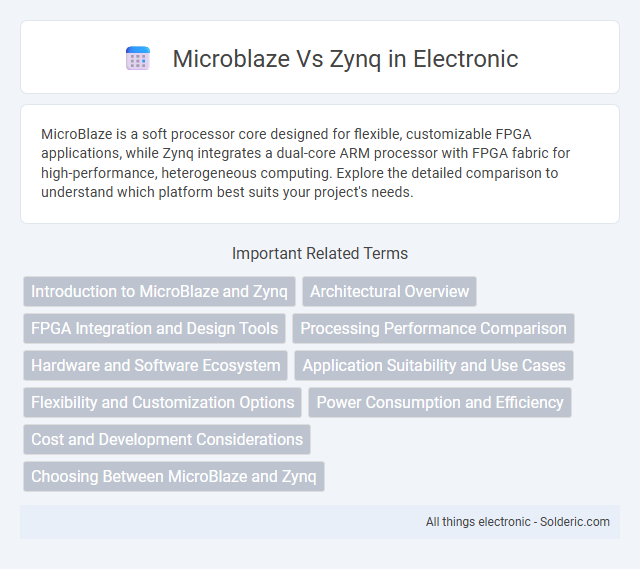MicroBlaze is a soft processor core designed for flexible, customizable FPGA applications, while Zynq integrates a dual-core ARM processor with FPGA fabric for high-performance, heterogeneous computing. Explore the detailed comparison to understand which platform best suits your project's needs.
Comparison Table
| Feature | MicroBlaze | Zynq |
|---|---|---|
| Type | Soft-core RISC processor | Programmable SoC (ARM Cortex-A9 + FPGA) |
| Architecture | 32-bit RISC | Dual-core 32-bit ARM Cortex-A9 + FPGA fabric |
| Performance | Up to 100 DMIPS (varies by configuration) | Up to 1 GHz ARM cores + FPGA acceleration |
| Integration | Implemented inside Xilinx FPGA | Integrated ARM cores + FPGA on single chip |
| Use Case | Embedded soft processor, customizable | High-performance embedded systems, complex processing |
| Memory | Configurable via FPGA logic, no fixed memory | On-chip RAM + external memory support |
| Development Tools | Xilinx Vivado, SDK, Vitis | Xilinx Vivado, SDK, Vitis |
| Cost | License-free soft IP core | Higher cost due to combined ARM + FPGA hardware |
Introduction to MicroBlaze and Zynq
MicroBlaze is a 32-bit soft processor core designed by Xilinx for FPGA-based applications, offering customizable and flexible embedded processing within the programmable logic. Zynq integrates a powerful ARM Cortex-A9 processor with FPGA fabric on a single chip, enabling high-performance system-on-chip (SoC) designs. Your choice between MicroBlaze and Zynq depends on project requirements, balancing between soft processor adaptability and the fixed ARM-based processing capabilities combined with hardware acceleration.
Architectural Overview
MicroBlaze is a 32-bit soft processor core optimized for Xilinx FPGAs, offering a modular, RISC architecture that can be customized for specific applications. Zynq integrates a dual-core ARM Cortex-A9 processor with programmable FPGA fabric on a single chip, combining high-performance processing and hardware acceleration. You benefit from MicroBlaze's flexibility within FPGA fabric, while Zynq provides a heterogeneous architecture for embedded systems requiring both software and hardware concurrency.
FPGA Integration and Design Tools
MicroBlaze is a soft processor core designed for Xilinx FPGAs, allowing flexible integration within FPGA fabric, while Zynq combines a hard ARM Cortex-A9 processor with FPGA logic on a single chip for enhanced performance and power efficiency. Xilinx's Vivado Design Suite supports both, but Zynq benefits from specialized tools like the Zynq Development Kit that streamline hardware-software co-design and debugging. You can leverage Zynq's tightly coupled architecture for complex embedded systems, whereas MicroBlaze offers scalable soft-core customization within FPGA designs.
Processing Performance Comparison
The Zynq SoC integrates a dual-core ARM Cortex-A9 processor delivering higher processing performance with clock speeds up to 1 GHz, suitable for demanding applications requiring robust computational power. In contrast, the MicroBlaze is a soft processor core implemented on FPGA fabric with flexible clock speeds typically up to 300 MHz, offering customizable processing capabilities but lower raw performance. While MicroBlaze provides configurability and resource efficiency for specific embedded tasks, Zynq's architecture enables superior multi-threaded and multimedia processing performance due to its hard processor system.
Hardware and Software Ecosystem
MicroBlaze is a soft processor core designed by Xilinx for implementation on FPGA fabric, offering flexibility in hardware customization but relying heavily on Xilinx's Vivado software tools for development. Zynq combines a dual-core ARM Cortex-A9 processor with FPGA logic on a single chip, providing a robust hardware platform with extensive support from both ARM and Xilinx ecosystems, including SDK and PetaLinux for software development. Your choice between MicroBlaze and Zynq should consider the integration level you require, as Zynq's hardened ARM cores give access to a broader software ecosystem and more powerful processing capabilities compared to the fully FPGA-dependent MicroBlaze.
Application Suitability and Use Cases
MicroBlaze is ideal for customizable, lightweight embedded applications requiring soft-core processors within FPGA environments, such as industrial automation and IoT devices. Zynq integrates a hard ARM Cortex-A9 processor with FPGA fabric, offering superior performance suited for complex tasks like advanced image processing, real-time data analytics, and high-speed communication systems. Your choice depends on whether flexibility and smaller footprint (MicroBlaze) or powerful processing with heterogeneous computing (Zynq) best fit your application's demands.
Flexibility and Customization Options
MicroBlaze offers extensive flexibility and customization through its soft-core architecture, enabling developers to tailor the processor configuration, including cache sizes, peripherals, and instruction sets, to specific application requirements. In contrast, Zynq combines a fixed ARM Cortex-A9 processor with programmable FPGA logic, providing a hybrid platform where software execution and hardware acceleration coexist, but with less processor customization than MicroBlaze. This hybrid architecture of Zynq delivers high performance and integration efficiency, while MicroBlaze excels in adaptable design scalability within Xilinx FPGA environments.
Power Consumption and Efficiency
MicroBlaze processors offer lower power consumption compared to Zynq devices due to their simpler, soft-core architecture allowing for customized configurations tailored to your application's efficiency needs. Zynq SoCs integrate ARM Cortex-A9 cores with programmable logic, resulting in higher power usage but delivering superior processing performance and system flexibility. Choosing between MicroBlaze and Zynq involves balancing your device's power constraints against computational demands to optimize overall efficiency.
Cost and Development Considerations
MicroBlaze is a cost-effective soft processor core ideal for FPGA designs requiring flexibility and lower upfront investment, while Zynq integrates a powerful ARM processor with programmable logic, resulting in higher initial costs but faster time-to-market for complex applications. Development with MicroBlaze involves FPGA tools and custom IP creation, offering greater control but increased design effort, whereas Zynq benefits from mature software ecosystems and hardware-software co-design, reducing development complexity. Your choice depends on balancing budget constraints against the need for processing performance and rapid development cycles.
Choosing Between MicroBlaze and Zynq
Choosing between MicroBlaze and Zynq depends on project requirements, including processing power, flexibility, and integration. MicroBlaze, a soft-core processor by Xilinx, offers customizable FPGA implementation ideal for lightweight and embedded applications. Zynq integrates a dual-core ARM Cortex-A9 with FPGA fabric, providing higher performance and seamless processing system and programmable logic combination for complex and compute-intensive tasks.
microblaze vs zynq Infographic

 solderic.com
solderic.com